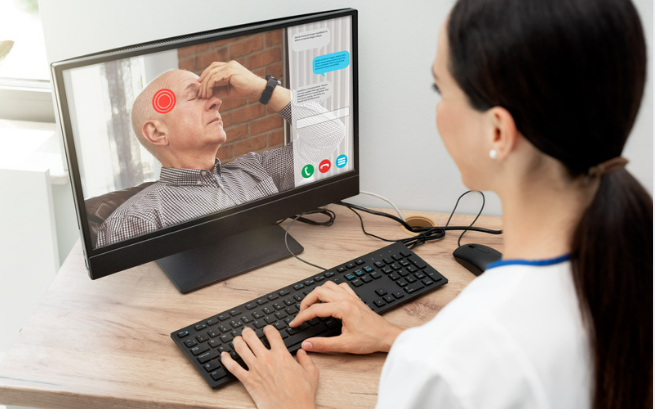Now that providers have returned to in-person appointments, many are wondering whether to make telehealth a permanent part of their service offerings going forward. That decision is often based on reimbursement models alone, without considering how telehealth might improve patient outcomes and value-based care payments. However, the answer becomes clear when putting patients first in this decision-making process. Video healthcare solutions can positively impact patient outcomes and reimbursement alike.
Chronic disease management
More than 70% of our nation’s total healthcare spending and 93% of Medicare spending go toward caring for patients with multiple chronic conditions. Most of these costs are related to “acute care hospital, and emergency department (ED) visits that could be prevented with earlier intervention.” For example, research has shown that for patients with Chronic Obstructive Pulmonary Disease, remote patient monitoring via telehealth can reduce hospitalizations by up to 35% and ED visits by 68%.
Leveraging video healthcare solutions along with wearable and remote devices help both patients and providers. Patients benefit from more timely and consistent health management, and providers benefit through increased reimbursement for improved outcomes.
Post-discharge care
Nearly one in five patients experience an adverse event within three weeks of being discharged from a hospital or ED, most of which are preventable. These events can lead to readmissions, trips to the emergency department, or worse. With video healthcare solutions, providers can continuously monitor and evaluate patients during this critical time to ensure they remain stable and well on their way to healing. If problems are detected, providers can quickly intervene to prevent complications.
ICU monitoring
Caring for critically ill patients requires a high level of clinical expertise and around-the-clock monitoring. Yet, with ongoing staffing shortages, it can be challenging for hospitals to staff their critical care departments fully. Providers can mitigate this challenge using video healthcare solutions to create a centralized ICU monitoring station. This technology allows clinicians to monitor multiple patients in multiple ICU locations from a single “command center.” This way, providers can allocate fewer resources without compromising care quality for their most vulnerable patients.

Falls prevention
More than 700,000 people fall in U.S. hospitals annually, resulting in approximately 250,000 injuries and close to 11,000 deaths. According to the CDC, around $50 billion is spent each year on medical costs associated with non-fatal fall injuries, and $754 million is spent on costs related to fatal falls.
Video healthcare solutions like VirtualSitter can help prevent falls by intervening. For example, a bedside monitor allows telesitters to see patients as they’re trying to get out of bed. Within seconds, they can notify a bedside clinician or floor nurse that the patient needs assistance. At the same time, the telesitter can inform the patient that help is on the way.
Rural healthcare
More than 46 million Americans—15% of the population—live in rural areas. Yet, only 8% of our nation’s physicians and surgeons choose to practice in rural communities. According to the CDC, up to 25% of those living in rural areas say there are times when they haven’t been able to get the care they need. Because of the lack of access to timely care, along with economic and lifestyle factors, rural populations are much more likely to suffer from chronic conditions, including heart disease, cancer, strokes, and lower respiratory diseases, as well as unintentional injuries/death, than their urban counterparts.
Video healthcare solutions can improve access to timely care for these underserved communities. They remove roadblocks like distance and lack of transportation by enabling providers and specialists to get the care they need right at home. In this way, these solutions are helping to address healthcare disparity, reduce costs, and improve population health.
Mental healthcare
The COVID-19 pandemic escalated the mental healthcare crisis in the U.S. The number of adults reporting feelings of anxiety and depression rose from 10% in 2019 to more than 40% in January 2021. Even before the pandemic, access to mental health resources was a significant problem with limited options and long waits to see a provider.
Video healthcare solutions can eliminate these obstacles by bringing mental healthcare to individuals when and where it’s most convenient for them. It can be challenging for patients to prioritize their mental health for many reasons, including social stigma, lack of providers in their area, requesting time off work, or finding childcare. These solutions provide a significant benefit by enabling more patients to get the care they need through convenient and discreet video appointments.
Care collaboration
High-quality clinician collaboration is a critical part of high-quality patient care. It can reduce medical errors and improve outcomes by enabling everyone on the care team—regardless of location—to work together on patient care. These solutions allow the inclusion of specialists and providers from disparate locations, as well as the patient’s family. This way, the patient can get the most appropriate care right where it’s needed.

Choosing the right video healthcare solution
Most providers already have a telehealth solution, but that doesn’t mean it’s the most effective solution for their organization. A long-term telehealth strategy requires video healthcare solutions that can meet the provider’s needs both today and into the future. VidyoHealth can help.
VidyoHealth provides video healthcare solutions that are built for end-to-end digital healthcare delivery. We help providers easily reach more patients across the care continuum. Our Virtual Care Platform is a flexible, scalable, and intuitive solution that enables providers to deliver fast, easy, and reliable virtual care experiences regardless of the patient’s location. This expands a provider’s outreach and brings much-needed care to those previously without access, like those living with mental health conditions or those located in rural areas. The Virtual Care Platform also enables more effective, timely collaboration between providers, specialists, and other clinicians through virtual rounding or bedside consults.
The VidyoHealth VirtualSitter solution enables around-the-clock monitoring of vulnerable patients, like those in the ICU or those at risk of falling. VirtualSitter also supports the remote management of patients who have just been discharged from the hospital or those living with chronic conditions. With VirtualSitter, clinicians can easily monitor multiple patients simultaneously on the same screen from any location. Conferencing with patients is simple, with onscreen buttons for audio-only or audio-visual calls. An easy-to-use zoom tool allows for better observation and enhanced clinician-patient engagement. And VirtualSitter makes it easy for clinicians to invite family members, providers, or specialists to join the conference via an onscreen email/SMS. There’s even a “doorbell” alert to let patients know a conference is about to begin and a privacy option patients can choose when having confidential conversations with family or friends.
VidyoHealth requires no technological investments, making it easy to get started. Providers can choose the deployment solution that works best for their unique requirements.
Learn why more than 4,000 healthcare providers trust VidyoHealth. Visit www.vidyohealth.com.
